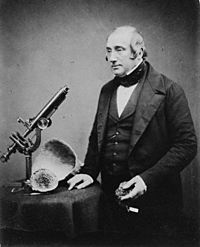James Scott Bowerbank facts for kids
Quick facts for kids
James Scott Bowerbank
|
|
|---|---|

James Scott Bowerbank
|
|
| Born | 14 July 1797 Bishopsgate, London
|
| Died | 8 March 1877 (aged 79) |
| Nationality | British |
| Scientific career | |
| Fields | naturalist |
| Signature | |
James Scott Bowerbank (born July 14, 1797 – died March 8, 1877) was a British scientist. He was a naturalist, which means he studied nature. He was also a palaeontologist, someone who studies fossils.
James Scott Bowerbank's Life
James Scott Bowerbank was born in Bishopsgate, a part of London. He worked with his brother in his family's business. They ran a distillery, which makes alcoholic drinks. He worked there until 1847.
From a young age, James loved learning about the stars (astronomy). He also enjoyed natural history, especially botany, the study of plants. He became very skilled at using a microscope. He used it to study the tiny details of shells, corals, moss agates, and flints. He also collected many fossils.
Studying London Clay Fossils
James was especially interested in the ancient remains found in the London Clay. This is a type of clay found in the London area. Around 1836, he and six other scientists started a group. They called themselves The London Clay Club.
The members included Dr. Bowerbank and other important researchers. They were Frederick E. Edwards, Searles Valentine Wood, John Morris, Alfred White, N. T. Wetherell, and James De Carle Sowerby. In 1840, Bowerbank wrote a book. It was called A History of the Fossil Fruits and Seeds of the London Clay. Two years later, he became a Fellow of the Royal Society. This is a very respected group of scientists.
Founding the Palaeontographical Society
In 1847, James suggested starting a new society. This group would publish information about British fossils that had not been described yet. This idea led to the creation of the Palaeontographical Society. This society still exists today.
From 1844 to 1864, James helped many people learn about science. He would invite students to his home every Monday evening. He lived first in Park Street, Islington, and later in Highbury Grove. At his home, students could see his amazing museum collection. They could also use his four microscopes. James would personally help anyone who was serious about learning.
He became very interested in studying sponges. He wrote a four-volume book about them. It was called A Monograph of the British Spongiadae. The Ray Society published it between 1864 and 1882. James retired in 1864 and moved to St Leonards-on-Sea. He passed away there on March 8, 1877.


